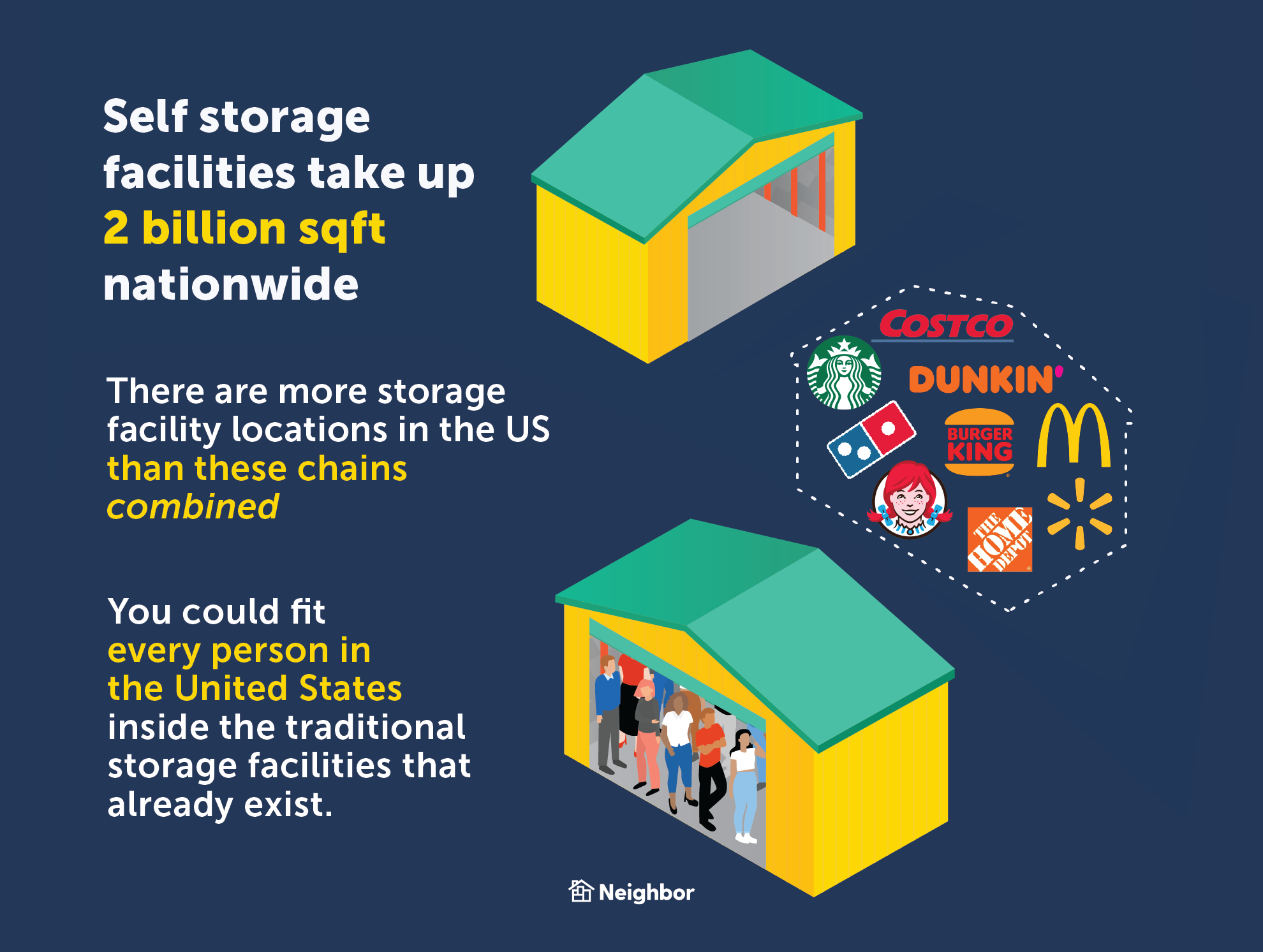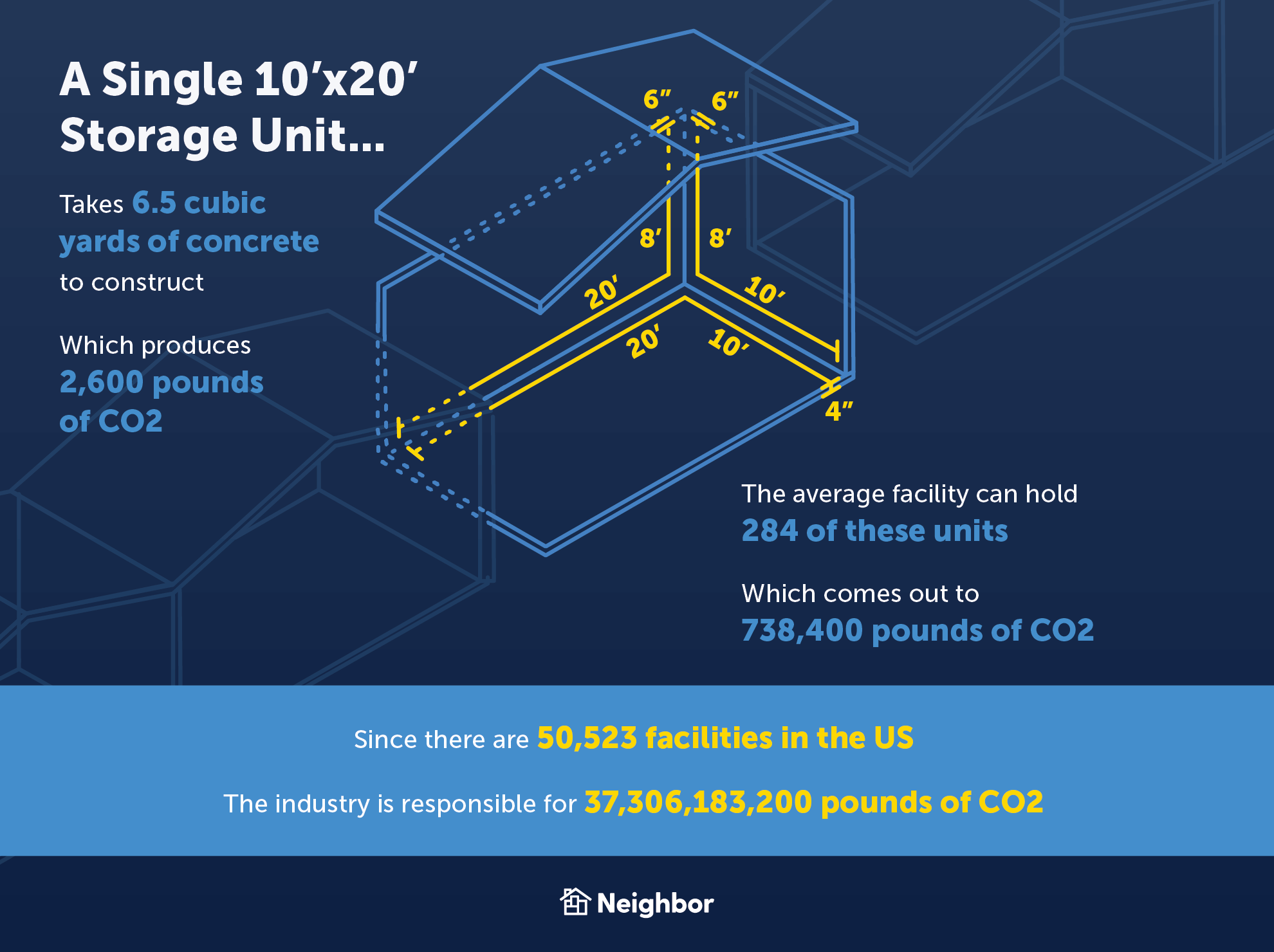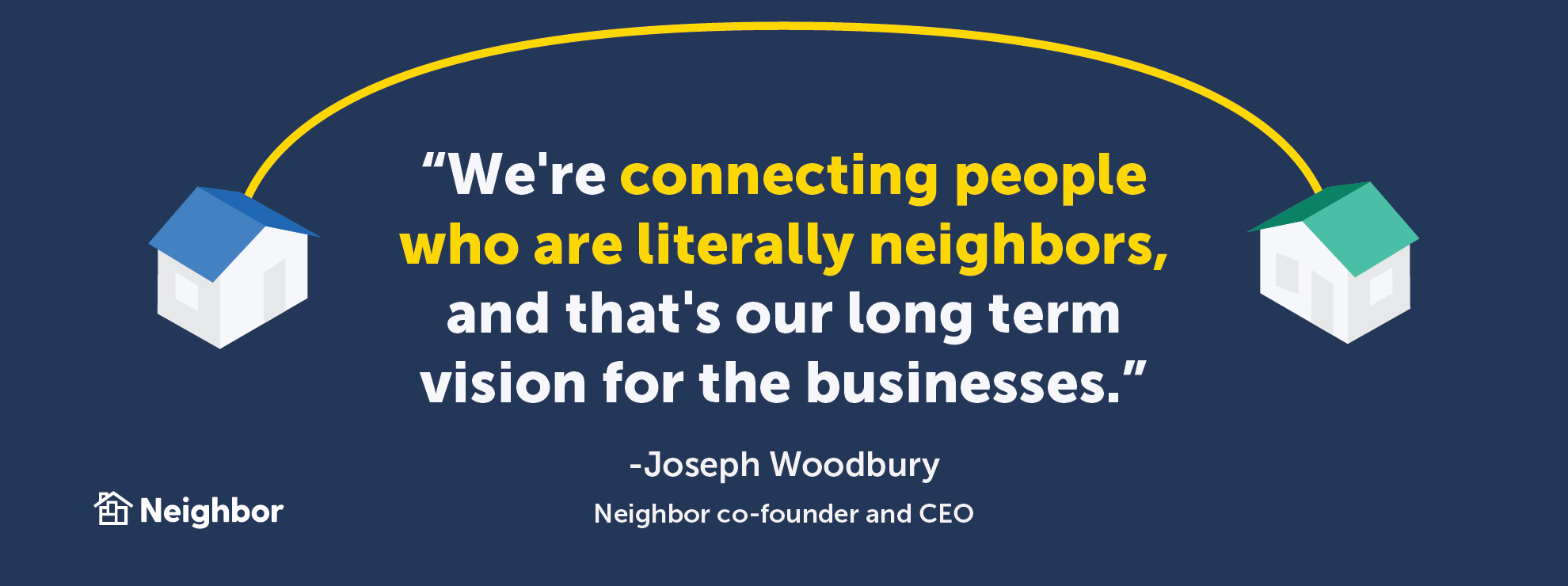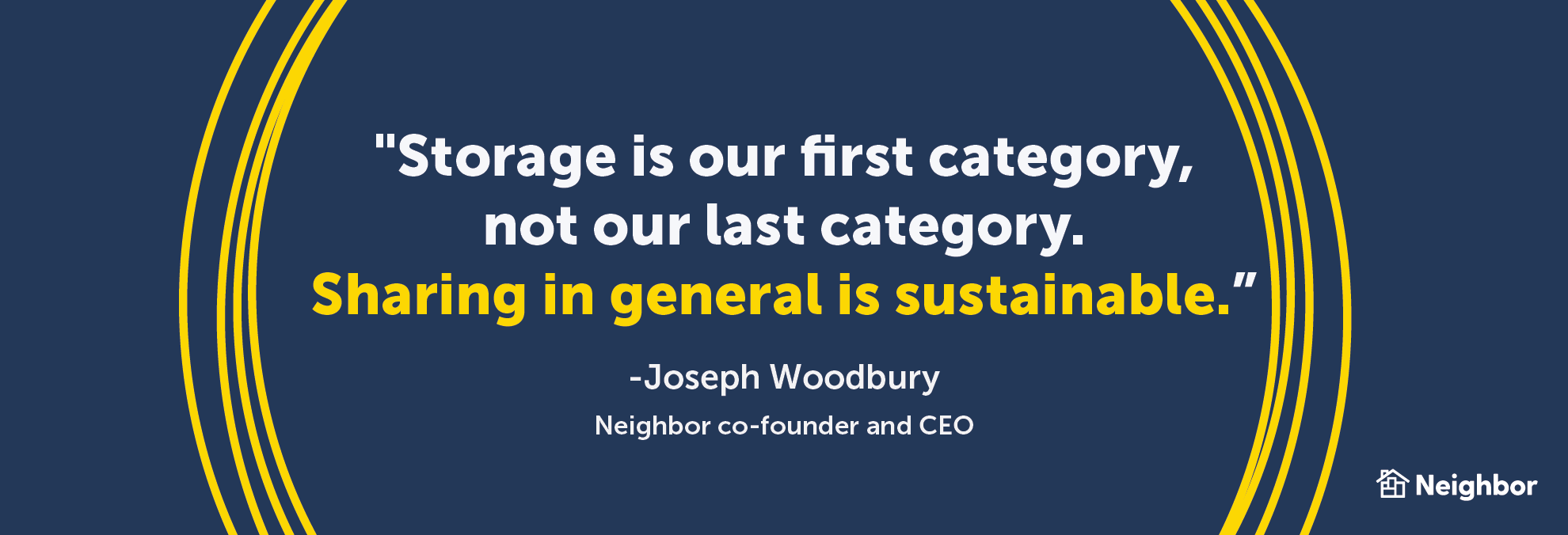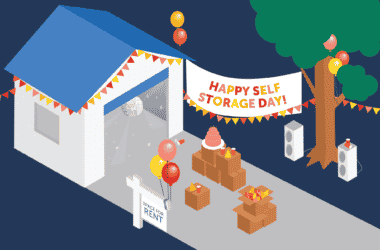If he could change one thing about the traditional self storage industry, Neighbor co-founder and CEO Joseph Woodbury has this to say: No new builds.
Part of what makes the traditional self storage industry unsustainable is its growth — the manufacture of massive buildings made of concrete and steel materials generates hundreds of thousands of pounds of carbon emissions each year. Woodbury sees a different future for storage: One where existing spaces are recycled to meet consumers’ storage needs, instead of meeting demand by constantly building more and more storage facilities.
In this series, we’ve talked about the negative environmental impact of the traditional storage industry, and how using Neighbor, a peer-to-peer storage marketplace, helps offset the industry’s carbon emissions. But Neighbor has bigger goals: To make the future of storage not just carbon-neutral, but carbon-negative. The only way to do it, according to Woodbury and Neighbor’s other leaders and investors, is to disrupt the self storage industry through sharing existing spaces — and stopping new storage facility builds in the process.
The Traditional Storage Industry is Growing Rapidly
The traditional self storage industry boasts an average occupancy rate of 96% across 2 billion square feet of existing storage space. There are more storage facility locations in the United States than there are McDonald’s, Starbucks, Dunkin Donuts, Burger King, Wendy’s, Domino’s, Walmart, Home Depot, and Costco — combined. And nearly all of it is full.
That’s why the industry is growing so rapidly.
“They’re not building to be frivolous,” Woodbury says. “They need to build because there is so much pent up demand.”
You could fit every man, woman, and child in the United States inside the traditional storage facilities that already exist. But it’s not enough space. Consumers still need more storage. And because of their demand, the industry keeps building more — on average they spend almost $5 billion per year just on new construction.
Storage Industry Growth is At the Heart of its Unsustainable Nature
That growth is a large part of what makes the traditional storage industry so unsustainable. Woodbury says that buildings tend to fly under the radar when it comes to how harmful their impact can be.
“This is a category that doesn’t get enough attention,” he says. “A lot of attention gets focused on cars, livestock, or airplanes, when 40% — literally four out of every 10 tons of greenhouse gas emissions that we put into the atmosphere come from buildings.”
This is something that leaders in the client movement are already sounding the alarm about. In an interview with Bill Gates about his book, How to Avoid a Climate Disaster, he said, “I actually thought of all the toughest climate problems that livestock was going to be the toughest… I’d say steel and cement are now the two that I’m still scratching my head.”
Steel is responsible for 7-8% of the entire globe’s yearly carbon emissions. The cement sector is the third-largest source of industrial pollution in the world — and cement is just one harmful ingredient used to make concrete. Traditional storage facilities are constructed from concrete and steel, generating massive amounts of greenhouse gasses in the process.
“If you go to a storage facility, it is it’s two ingredients, right? It’s concrete, and steel, which are the two problems,” Woodbury says. “Those are the two that matter the most.”
Neighbor is Building a Carbon-Negative Future Through the Sustainability of Community
When Woodbury watches the traditional storage industry continue to grow, despite the harm it causes to the environment, he knows there’s a better path forward. Rather than require harmful new construction to meet demand, Neighbor is using spaces that already exist — and creating connections between people in the process.
“Think of us as a big recycling company — that’s essentially what we are,” he says. “Except, instead of recycling plastic bottles and cardboard boxes, we’re recycling buildings. In other words, we’re taking the space that we have already built all over the country, and we’re putting it to good use to prevent future building.”
But Woodbury’s — and other company leaders’ — vision for Neighbor is even greater than that. The true key to creating sustainable companies, Woodbury says, is harnessing the power of communities.
“This idea of community and sharing is very important to us,” he says. “We view ourselves as the first truly hyperlocal marketplace.”
Woodbury compares Neighbor to well-known sharing economy platforms like Uber or Airbnb, but there’s a key difference.
“You use Uber when you’re in another city, and it’s great, but you’re probably never going to talk to your Uber driver ever again. Or you use Airbnb when you’re traveling, but you’re not as likely to make lasting connections through that platform.”
Neighbor, on the other hand, is creating connections between people who live in the same communities.
“We’re connecting people who are literally neighbors, and that’s our long term vision for the business,” Woodbury says. “We don’t just want to stop with storage. We think the most powerful asset on our platform is that we have neighbors in every city in every state in the country, opening up their homes to each other. And we want to create more ways for them to share more things with their neighbors.”
This is an idea that’s already gaining steam among sustainability-minded consumers. There are more platforms than just Neighbor — for example, Turo, a marketplace for renting or borrowing a neighbor’s car, or Spartoolz, an app that connects people who need to borrow or rent tools with neighbors who own them Also rising in popularity are local “Buy Nothing” groups — part of a growing movement called the “gift economy,” in which members believe their communities already contain everything they need, and they can thrive (and reduce environmental impact) by sharing freely with one another.
Neighbor’s vision is to build a carbon-negative future for the storage industry — but Woodbury says he doesn’t plan to stop there. Beyond the powerful community connections he’s already seen formed through Neighbor, Woodbury believes there’s an even greater impact that can be achieved by harnessing the power of communities.
“Storage is our first category, not our last category,” he says. “Sharing in general is sustainable. There’s maybe some divisiveness when it comes to sustainability. But I don’t think there’s any divisiveness around the concept of sharing. So if we can all rally around this concept of sharing and using our resources — that’s all that sustainability is trying to do is use resources more efficiently. That’s part of the reason why we believe in sustainability: because sustainability, sharing, and community are all interconnected.”
A More Sustainable Future Requires a New Kind of Leadership
A shift is also apparent in the startup world, where investors are increasingly focusing on sustainable businesses.
Andreessen Horowitz, the venture capital firm that led Neighbor’s Series A in 2020, has been open about looking for sustainability-minded companies to support. High-profile additions to its portfolio in recent years include Silo, a platform that helps build more transparent supply chains for perishable foods; Patch, a carbon-offset API developer; and KoBold, a startup dedicated to making cobalt mining for technology manufacturing more ethical and sustainable.
“As an investor, I often look for companies that transform underutilized assets for the better,” Andreessen Horowitz general partner Jeff Jordan says. “Neighbor does just this by empowering homeowners to recycle their space for extra storage–helping their community store things locally and reducing carbon emissions in the process.”
For Woodbury and other leaders at Neighbor, it’s a goal they hope inspires people to work together toward a better future.
“Sustainability has always been something we’ve cared about,” he says. “We don’t just want it to be us. We hope there’s more people that see this model of peer-to-peer recycling and decide to use their own assets better. And we hope other people will start other companies that recycle assets. We hope other people will start other companies that encourage sharing and community. We hope we’re just the first, and this becomes the norm.”
Next up: The Carbon Offset of Using Neighbor

